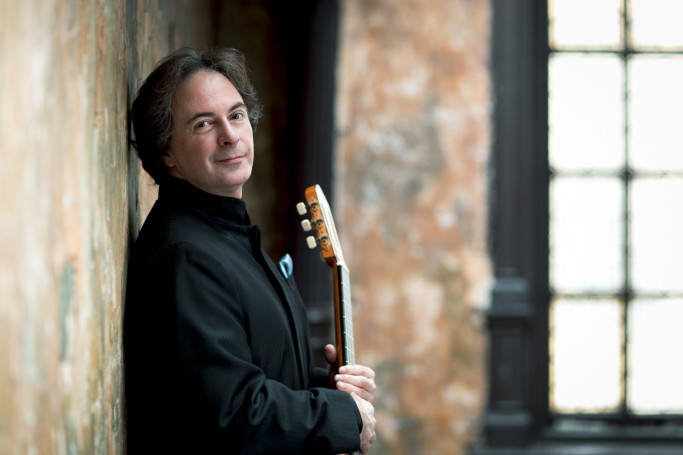Christoph Denoth, guitar in Review
Christoph Denoth, guitar SubCulture, New York, NY September 4, 2014
What better way to begin a new concert season than to attend a wonderful performance in one of New York’s new concert venues? The performer: Swiss guitarist Christoph Denoth. The music: works by the English composers John Dowland (1563-1626) and Benjamin Britten, Spaniards Manuel de Falla, Joaquin Turina, Isaac Albéniz, and the Brazilian Heitor Villa-Lobos. The venue: an intimate performance space with a bar in NoHo at 45 Bleeker Street.
A comfortable basement space, SubCulture is a perfect venue for an intimate guitar recital. (The festival of piano music scheduled for the month of September should also be a great fit.) Although Mr. Denoth was surrounded by microphones, the sound from where I sat seemed natural and unamplified. When, after the concert, I spoke to the sound engineer, he told me that the microphones were for a radio broadcast of the performance. I suggested that the audience should be forewarned when broadcast microphones appear on stage during concerts that shouldn’t have amplification. I also mentioned that even though the presence of a bar makes SubCulture more informal than a traditional “concert hall,” piped in music (cool jazz this night) right before and after the recital is not a good idea. Music such as we heard tonight needs a no-music frame of silence before and after the performance.
Christoph Denoth has performed in concert halls all over the world, as a solo artist and in collaboration with orchestras, chamber groups and singers. He is sought after as a teacher and is now on the faculty of the Royal Academy of Music in London. This evening’s performance showed why. A master of his instrument, he performed with great technical skill, spinning out well-shaped melodic lines with crystal clear, often thrilling, accompaniments. He drew from his instrument so many different colors that one often thought there was more than one guitarist on stage.
The recital began with guitar arrangements of four works for lute by John Dowland. They included a setting of the melody of a popular ballad of the times and of one by Dowland himself, a dance, and a fantasy. These delightful works, elegantly performed, were the perfect vehicle to enable the audience to “tune their ears” to the softer end of the guitar’s dynamic range. This was followed by Manuel de Falla’s Homenaje – Tombeau de Debussy. (A tombeau is a musical composition commemorating the death of a notable individual.) Although one couldn’t know it at the time, Mr. Denoth’s performance of this work marked the beginning of his ever increasing creation of more and more beautiful and interesting guitar colors.
Benjamin Britten’s Nocturnal after John Dowland, Op.70, uses as its inspiration Dowland’s lute song “Come Heavy Sleep.” Commissioned by the legendary English guitarist Julian Bream, the work makes great demands on the performer. Mr. Denoth was up to the challenge and performed with assurance and consummate musicality. Each of the eight movements utilizes tiny motives and fragments from Dowland’s song, but the complete song is not heard until the end of the work. Although I’ve conducted “Come Heavy Sleep” in Dowland’s arrangement for four voices, I had great difficulty figuring out what was going on musically. It just sounded like a series of guitar effects, beautifully played, but having little to do with Dowland’s song.
Next came what, for me, was the program’s high point: a performance of four of the Cinq Préludes by Heitor Villa-Lobos. Villa-Lobos knew what was idiomatic to the guitar and Mr. Denoth reveled in this wonderful writing. It was joyous and compelling music-making. In Prélude No.1 (Homage to Back-Country Brazil) Mr. Denoth beautifully contrasted the sound of the long melodic line and the chordal accompaniment. The melody first appeared in the bass with the chords above. When it returned, now in the soprano, the color of the melody was again quite different from that of the accompaniment. The Préludes were not performed in the published order. The next, Prélude No.4, featured mysterious harmonics; No.3 was expressive and beautifully phrased. The wild strumming at the end of No.2 brought the set to a stirring conclusion.
The recital ended with three popular works familiar to most of the audience, Joaquin Turina’s Sevillana (Fantasia) Op.29, and Isaac Albéniz’s Granada and Asturias. The program didn’t mention that the two Albéniz works were originally written for piano in 1890 and arranged for guitar after his death in 1909. I was wrong in thinking it would be difficult to maintain the excitement created by the Villa-Lobos Préludes. These last three works were a thrilling ending to the concert proper.
The Spanish aspect to the program continued with the first encore, an idiomatic performance of Joaquin Malats’s Serenata Española, another work written for piano but later transcribed for guitar. It seems that, in their nationalistic works, Spanish composers sought to have the piano imitate the most Spanish of instruments. This evening’s arrangements for guitar only bought these works closer to their roots. A final work by Dowland, Mr. Dowland’s Midnight, brought this wonderful concert to a gentle close.

